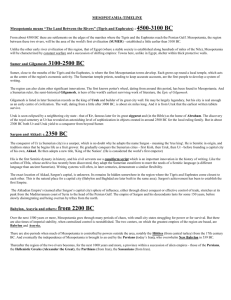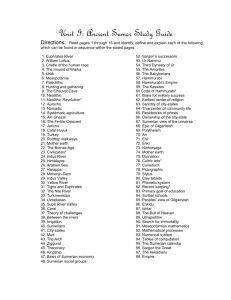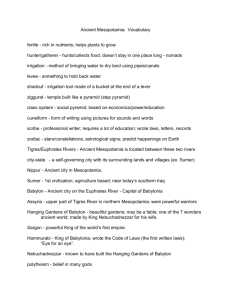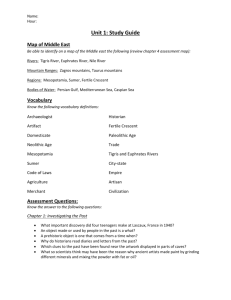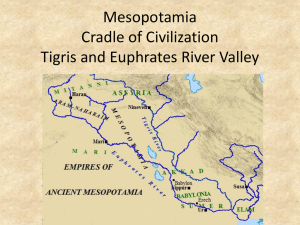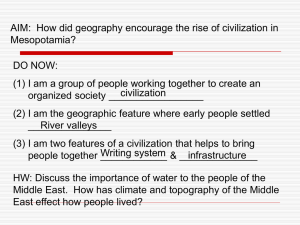Definition
advertisement
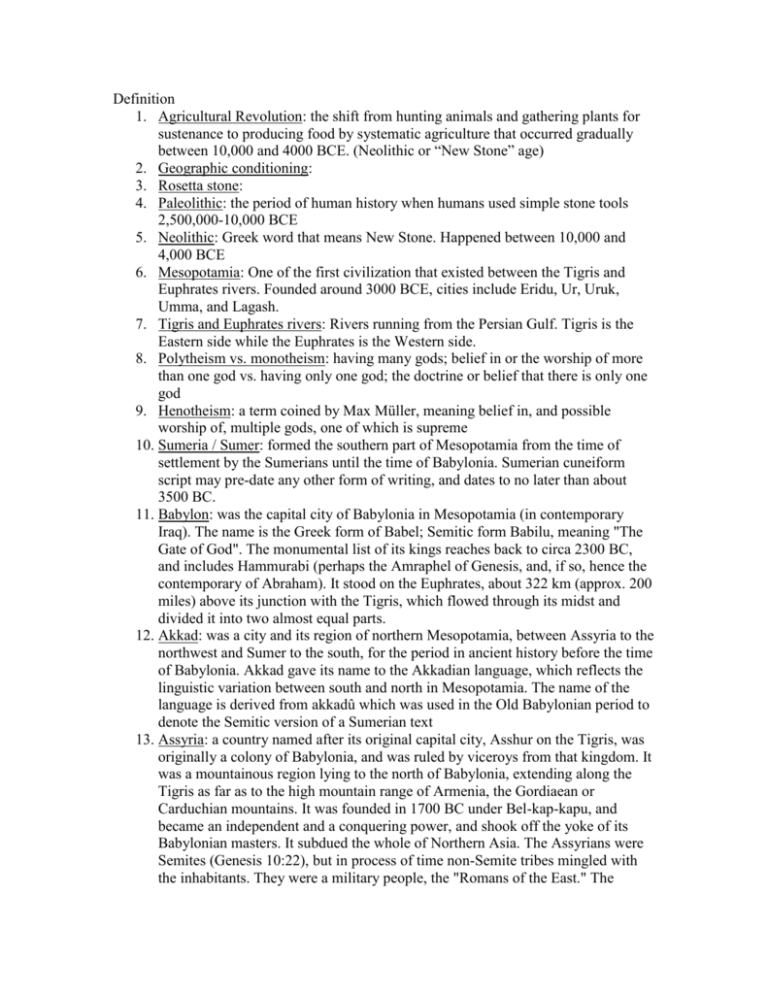
Definition 1. Agricultural Revolution: the shift from hunting animals and gathering plants for sustenance to producing food by systematic agriculture that occurred gradually between 10,000 and 4000 BCE. (Neolithic or “New Stone” age) 2. Geographic conditioning: 3. Rosetta stone: 4. Paleolithic: the period of human history when humans used simple stone tools 2,500,000-10,000 BCE 5. Neolithic: Greek word that means New Stone. Happened between 10,000 and 4,000 BCE 6. Mesopotamia: One of the first civilization that existed between the Tigris and Euphrates rivers. Founded around 3000 BCE, cities include Eridu, Ur, Uruk, Umma, and Lagash. 7. Tigris and Euphrates rivers: Rivers running from the Persian Gulf. Tigris is the Eastern side while the Euphrates is the Western side. 8. Polytheism vs. monotheism: having many gods; belief in or the worship of more than one god vs. having only one god; the doctrine or belief that there is only one god 9. Henotheism: a term coined by Max Müller, meaning belief in, and possible worship of, multiple gods, one of which is supreme 10. Sumeria / Sumer: formed the southern part of Mesopotamia from the time of settlement by the Sumerians until the time of Babylonia. Sumerian cuneiform script may pre-date any other form of writing, and dates to no later than about 3500 BC. 11. Babylon: was the capital city of Babylonia in Mesopotamia (in contemporary Iraq). The name is the Greek form of Babel; Semitic form Babilu, meaning "The Gate of God". The monumental list of its kings reaches back to circa 2300 BC, and includes Hammurabi (perhaps the Amraphel of Genesis, and, if so, hence the contemporary of Abraham). It stood on the Euphrates, about 322 km (approx. 200 miles) above its junction with the Tigris, which flowed through its midst and divided it into two almost equal parts. 12. Akkad: was a city and its region of northern Mesopotamia, between Assyria to the northwest and Sumer to the south, for the period in ancient history before the time of Babylonia. Akkad gave its name to the Akkadian language, which reflects the linguistic variation between south and north in Mesopotamia. The name of the language is derived from akkadû which was used in the Old Babylonian period to denote the Semitic version of a Sumerian text 13. Assyria: a country named after its original capital city, Asshur on the Tigris, was originally a colony of Babylonia, and was ruled by viceroys from that kingdom. It was a mountainous region lying to the north of Babylonia, extending along the Tigris as far as to the high mountain range of Armenia, the Gordiaean or Carduchian mountains. It was founded in 1700 BC under Bel-kap-kapu, and became an independent and a conquering power, and shook off the yoke of its Babylonian masters. It subdued the whole of Northern Asia. The Assyrians were Semites (Genesis 10:22), but in process of time non-Semite tribes mingled with the inhabitants. They were a military people, the "Romans of the East." The Assyrians established "merchant colonies" in Anatolia, e.g., at Kültepe circa 1920 BC - 1840 BC and 1798 BC - 1740 BC. By doing so they supplied the future Hittites with much useful technology. 14. Gilgamesh/Enkidu/Ishtar/Utnapishtam the Faraway: In Babylonian mythology, King Gilgamesh lived and reigned about 2700 BC. According to the Sumerian king list, he was the fourth king of Uruk in Sumer and he was succeeded by his son Ur-Nungal who ruled for 30 years. Sky-god Anu creates the wild-man Enkidu. Enkidu is tamed by the temple prostitute Shamhat. Gilgamesh rejects the sexual advances of the goddess Ishtar. Ishtar gets her father, the sky-god Anu, to send the "Bull of Heaven" to avenge Gilgamesh and his city. Gilgamesh and Enkidu kill the bull. Utnapishtim in the Akkadian sources, a wise citizen of Shurrupak on the banks of the Euphrates, or Ziusudra in the Sumerian poems a wise king and priest of Shurrupak, appears in the Epic of Gilgamesh as one of the two human survivors, along with his wife and with 'the seed of all living creatures' of a great flood sent by Enlil to kill everything on Earth. The Flood episode occurs in the eleventh table of the Gilgamesh epic. Utnapishtim was secretly warned by the water god Ea of Enlil's plan, and constructed a boat to save himself and representatives of each species of animal. 15. Lugal: Sumerian King that apparently was know for the expansion of its country 16. Ziggurat: is a temple tower of the ancient Mesopotamian valley, having the form of a terraced pyramid of successively receding stories. Looking at the dictionary's description above, one can in the most basic ways formulate an image of what a ziggurat looked like. However, ziggurats spanned from the simplest base which a temple sat upon, to marvels of mathematics and constructions, spanning several terraced stories and topped with a temple fit for any God 17. Semitic language tree: 18. Sargon: was the first person in recorded history to create an empire, or multiethnic state. His empire encompassed the region of the Tigris and Euphrates rivers, and part of what is present-day Turkey. His capital was Agade in Akkad. Sargon of Akkad was probably the same person as the first Sargon of Assyria (also known as Sharrukin or Sharru-kin). Sargon's empire would presumably have included Assyria. He is listed in the Assyrian king list as the son of Ikunum and the founder of a dynasty. 19. Enlil/Marduk/EA/Inanna/Shamash: Enlil was the name of a chief deity in Babylonian religion, perhaps pronounced and sometimes rendered in translations as Ellil in later Akkadian. The name is Sumerian and has been believed to mean 'Lord Wind' though that is debated. Enlil was the god of wind, or the sky between earth and heaven. One story has him originate as the exhausted breath of An (God of the heavens) and Ki (goddess of the Earth) after sexual union. Another accounts is that he and his sister Ninhursag/Ninmah/Aruru were children of an obscure god Enki 'Lord Earth' (not the famous Enki) by Ninki 'Lady Earth'. Marduk was the name of a late generation god from ancient Mesopotamia and patron deity of the city of Babylon, who, when Babylon permanently became the political centre of the united states of the Euphrates valley under Hammurabi (c. 2250 BC), rose to the position of the head of the Babylonian pantheon. EA originally Enki, the patron deity of the city of Eridu, situated in the wetlands of the Euphrates valley at some distance from the Persian Gulf. Eridu, meaning "the good city," was one of the oldest settlements in the Euphrates valley, and is now represented by the mounds known as Abu Shahrein. In the absence of excavations on that site, we are dependent for our knowledge of Ea on material found elsewhere. This is, however, sufficient to enable us to state definitely that Ea was a water-deity, lord especially of the water under the earth, the Apsu. Whether Ea (or A-e as some scholars prefer) represents the real pronunciation of his name we do not know. Summerian’s Inanna is the counterpart to Ishtar. 20. Hammurabi: He reunified Sumer and Akkad and reunified Mesopotamia as whole. Called himself the sun of Babylon and created The Code of Hummurabi. 21. Third Dynasty of Ur: 22. Amorites: refers to a Semitic people who occupied the middle Euphrates area from the second half of the third millennium BC and also appear in the Tanach. 23. Cuneiform writing: “wedge-shaped.” A system of writing developed by the Sumerians that consisted of wedge-shaped impressions made by a reed stylus on clay tablets 24. Stele: The Mesha Stele (popularized in the 19th century as the "Moabite Stone") is a black basalt stone, bearing an inscription by the 9th century BC Moabite King Mesha, discovered in 1868. The stone is 124 cm high and 71 cm wide and deep, and rounded at the top. The inscription of 34 lines, the most extensive inscription ever recovered from ancient Palestine, was written in Hebrew-Phoenician characters. It was set up by Mesha, about 850 BCE, as a record and memorial of his victories in his revolt against Israel, which he undertook after the death of his overlord, Ahab, recounting

